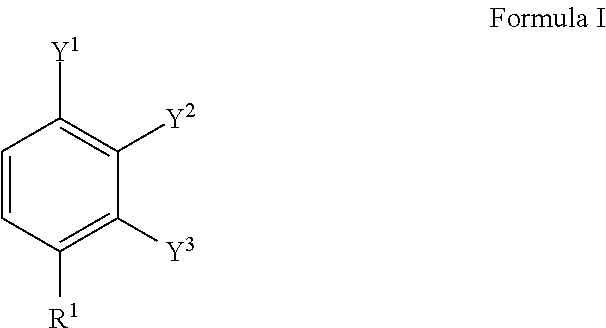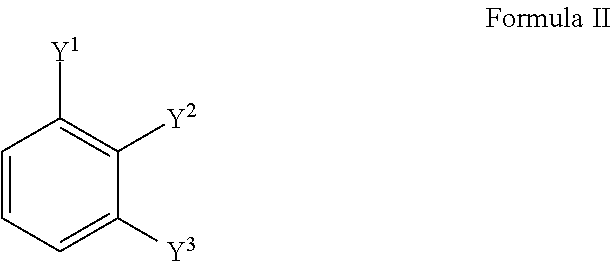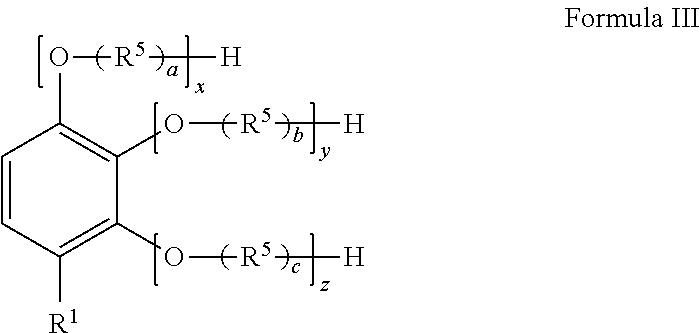Nitrogen-Free Deposit Control Fuel Additives and One Step Process for the Making Thereof
a technology of nitrogen-free deposit control and additives, which is applied in the direction of fuels, mechanical equipment, machines/engines, etc., can solve the problems of increasing engine emissions, reducing the maximum power of the engine, and reducing fuel economy, so as to improve performance, compare and/or improve performance. the effect of good performance of fuel detergent additives
- Summary
- Abstract
- Description
- Claims
- Application Information
AI Technical Summary
Benefits of technology
Problems solved by technology
Method used
Image
Examples
example 1
[0076]A nitrogen free additive is prepared by adding pyrocatechol (330 g; 3 moles), mixed with toluene (302 g), to a 2-liter glass reaction flask equipped with cold water condenser, caustic scrubber, subline addition tube, thermo-couple, and over head mechanical stirrer. The mixture is stirred for 15 minutes under a nitrogen blanket. The catalyst BF3 etherate (20.6 g; 0.145 moles) is added dropwise over 30 minutes while maintaining the reaction temperature below 25 degrees C. Mixed vinylidene 1000 Mn polyisobutylene, TPC 1105™ available from the Texas Petrochemicals LP, (501 g; 0.50 moles) is mixed with toluene (202 g), is then added drop wise over a 3 hour period maintaining the reaction temperature below 25 degrees C. The mixture is then stirred for 22 hours at 20 to 25 degrees C. Calcium hydroxide (32.3 g; 0.436 moles) is then added to quench the catalyst. The reaction mixture is then filtered and vacuum stripped to remove the solvent. The resulting product is a polyisobutylene p...
example 2
[0077]A nitrogen free additive is prepared by adding pyrogallol (60 g; 0.476 moles), mixed with toluene (70 g), to a 1-liter glass reaction flask equipped with cold water condenser, caustic scrubber, subline addition tube, thermo-couple, and over head mechanical stirrer. The mixture is stirred for 15 minutes under a nitrogen blanket. The catalyst BF3 etherate (7.27 g; 0.051 moles) is added dropwise over 30 minutes while maintaining the reaction temperature below 25 degrees C. Mixed vinylidene 1000 Mn polyisobutylene, TPC 1105™ available from the Texas Petrochemicals LP, (183 g; 0.183 moles) mixed with toluene (150 g), is then added dropwise over an 100 minute period maintaining the reaction temperature below 25 degrees C. The mixture is then stirred for 24 hours at 20 to 25 degrees C. Calcium hydroxide (15 g; 0.2 moles) is then added to quench the catalyst. The reaction mixture is then filtered and vacuum stripped to remove the solvent. The resulting product is a polyisobutylene pyr...
example 3
[0078]A nitrogen free additive is prepared by adding pyrocatechol (330 g; 3.0 moles), mixed with toluene (520 g), to a 5-liter glass reaction flask equipped with cold water condenser, caustic scrubber, subline addition tube, thermo-couple, and over head mechanical stirrer. The mixture is stirred for 15 minutes under a nitrogen blanket. The catalyst BF3 etherate (55.6 g; 0.39 moles) is added dropwise over 30 minutes while maintaining the reaction temperature below 25 degrees C. Mixed vinylidene 1000 Mn polyisobutylene, TPC 1105™ available from the Texas Petrochemicals LP, (1999.7 g; 2.00 moles) mixed with toluene (975 g), is then added drop wise over a 3 hour period maintaining the reaction temperature below 25 degrees C. The mixture is then stirred for 22 hours at 20 to 25 degrees C. Calcium hydroxide (96 g; 1.30 moles) is then added to quench the catalyst. The reaction mixture is then filtered and vacuum stripped to remove the solvent. The resulting product is a polyisobutylene pyr...
PUM
| Property | Measurement | Unit |
|---|---|---|
| Fraction | aaaaa | aaaaa |
| Fraction | aaaaa | aaaaa |
| Mass | aaaaa | aaaaa |
Abstract
Description
Claims
Application Information
 Login to View More
Login to View More - R&D
- Intellectual Property
- Life Sciences
- Materials
- Tech Scout
- Unparalleled Data Quality
- Higher Quality Content
- 60% Fewer Hallucinations
Browse by: Latest US Patents, China's latest patents, Technical Efficacy Thesaurus, Application Domain, Technology Topic, Popular Technical Reports.
© 2025 PatSnap. All rights reserved.Legal|Privacy policy|Modern Slavery Act Transparency Statement|Sitemap|About US| Contact US: help@patsnap.com



